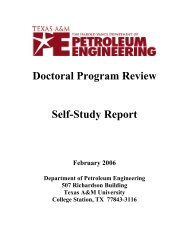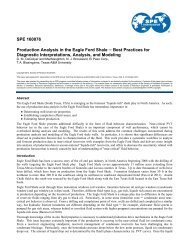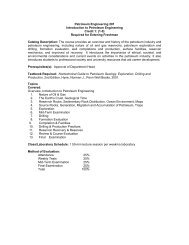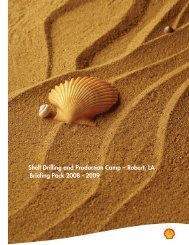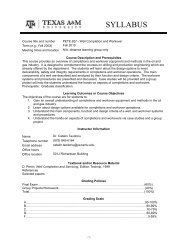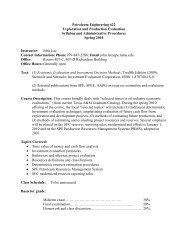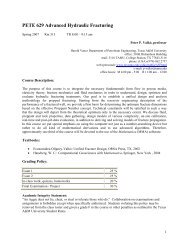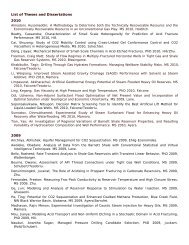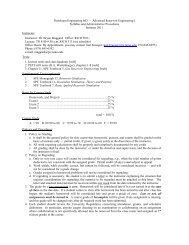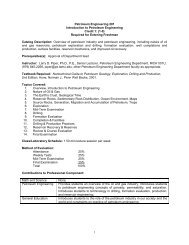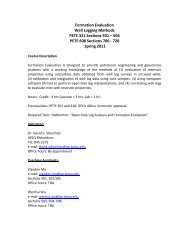Crisman Annual Report 2009 - Harold Vance Department of ...
Crisman Annual Report 2009 - Harold Vance Department of ...
Crisman Annual Report 2009 - Harold Vance Department of ...
Create successful ePaper yourself
Turn your PDF publications into a flip-book with our unique Google optimized e-Paper software.
Enhanced Oil Recovery <strong>of</strong> Viscous Oil by Injection <strong>of</strong> Water-in-Oil Emulsions<br />
Objectives<br />
Water-in-Oil (W/O) emulsions have been used for<br />
enhancing oil recovery by improving the mobility<br />
ratio, thus sweep efficiency, and by miscibility with<br />
the reservoir oil, thus reducing residual oil. Heavy<br />
crude oil has been used to make W/O emulsions<br />
(with addition <strong>of</strong> nanoparticles) to recover the<br />
same oil with very good recovery in a core flooding<br />
experiment. However, crude oil emulsions become<br />
much more viscous as more water is added, resulting<br />
in poor injectivity.<br />
Our research objectives are therefore as follows:<br />
» Find an oil that can be used to make a moderately<br />
viscous emulsion system.<br />
» Make stable W/O emulsions out <strong>of</strong> this oil without<br />
the addition <strong>of</strong> expensive components (e.g.,<br />
surfactant).<br />
» Verify the performance <strong>of</strong> the emulsion by core<br />
flooding experiments.<br />
Approach<br />
We will make emulsions by adding water into<br />
different types <strong>of</strong> oil, and blending them with a<br />
blender. Nanoparticles might be mixed into the oil<br />
prior to the addition <strong>of</strong> water. If a stable emulsion is<br />
obtained, its viscosity will be measured at different<br />
water content, shear rate, and temperature.<br />
Accomplishments<br />
Used engine oil is found to be a very good candidate<br />
to make stable emulsions (Fig. 1) for several<br />
reasons:<br />
» Existing soot provides perfect oleophilic<br />
nanoparticles to stabilize the W/O emulsion.<br />
» Moderate oil viscosity allows moderately high<br />
viscosity achievement for the emulsion (Fig. 2).<br />
» Stable and well behaved emulsions are obtained<br />
simply by blending in water, without extra<br />
surfactant or nanoparticles needed.<br />
» Used engine oil is produced in large quantities (~1<br />
billion gallons/year) and needs to be recycled–it is<br />
therefore relatively cheap.<br />
Significance<br />
A simple formulated stable emulsion system is<br />
obtained, with high potential use as a displacement<br />
fluid for heavy oil EOR.<br />
46<br />
Fig. 1. W/O emulsion with used Pennzoil 5W-30 is stable with water<br />
content up to 70%.<br />
Viscosity (cp)<br />
100000<br />
10000<br />
1000<br />
100<br />
Project Information<br />
1.7.4 Experimental Study <strong>of</strong> Polymer-Solvent Injection for<br />
Enhanced Oil<br />
Related Publications<br />
Bragg, J.R. 1999. Oil Recovery Method Using an Emulsion.<br />
US Patent 5,885,243.<br />
D’Elia, S. R. and Ferrer, G. J. Emulsion Flooding <strong>of</strong> Viscous<br />
Oil Reservoirs. Paper SPE 4674, presented at the 1973<br />
annual meeting <strong>of</strong> SPE <strong>of</strong> AIME, Las Vegas, Nevada, 30<br />
September.<br />
Johnson, C. E. Jr. Status <strong>of</strong> Caustic and Emulsion Methods.<br />
JPT (January 1976) 85-92.<br />
Contacts<br />
Daulat Mamora<br />
979.845.2962<br />
daulat.mamora@pe.tamu.edu<br />
Xuebing Fu<br />
10<br />
0<br />
50 100 150<br />
Shear rate (s -1 )<br />
200<br />
CRISMAN INSTITUTE<br />
0% water<br />
20% water<br />
40% water<br />
50% water<br />
60% water<br />
70% water<br />
Fig. 2. Viscosity at 25ºC <strong>of</strong> W/O emulsion with used Pennzoil 5W-30<br />
engine oil.<br />
<strong>Crisman</strong> <strong>Annual</strong> <strong>Report</strong> <strong>2009</strong>



